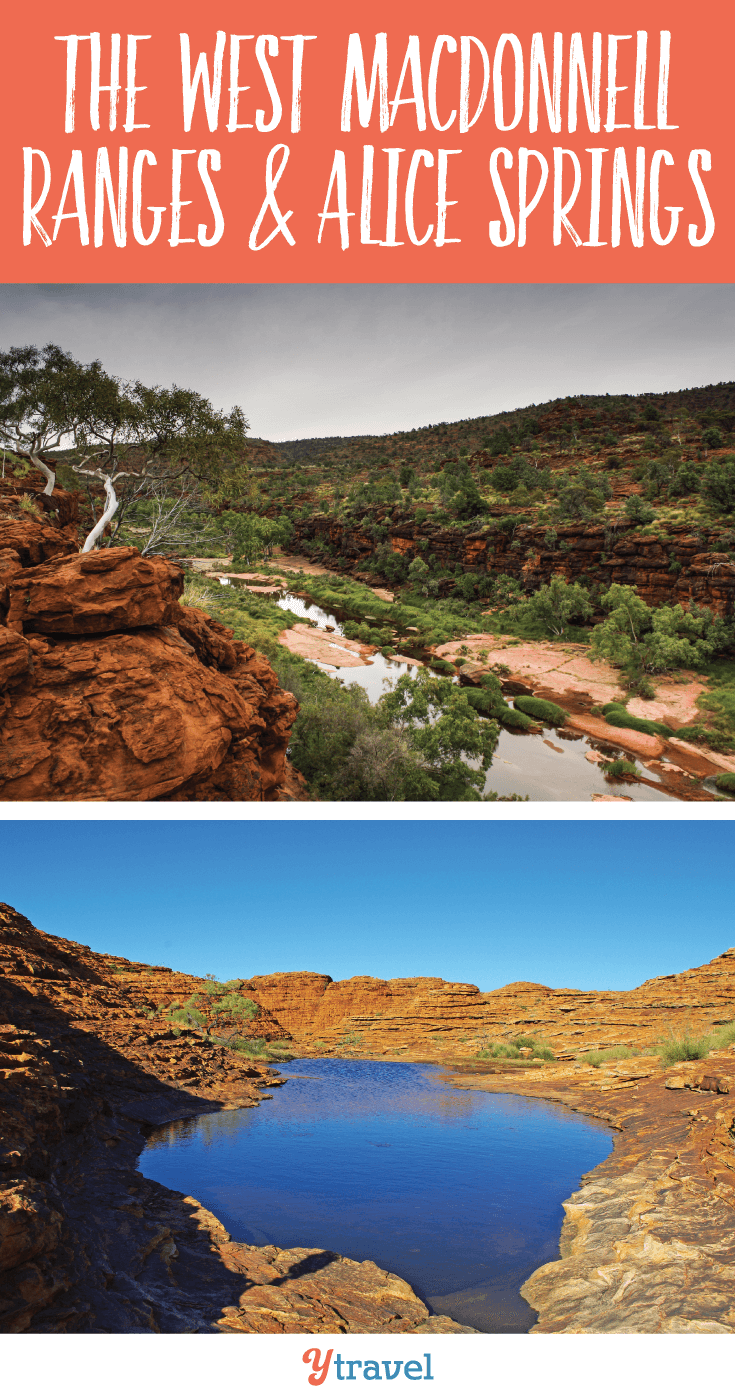This post may contain affiliate links. We may receive a small commission, at no cost to you, if you make a purchase. Read Disclosure.
One of the things I learned on our road trip around Australia was that you should always allow yourself to be surprised, which is how I felt when I visited the West MacDonnell Ranges in Alice Springs.
Located in the West MacDonnell National Park, or Tjoritja as it’s known to its traditional owners, is a vast region of incredible rock formations, canyons and creeks, viewpoints and hikes, and many scenic drives.

While many people visit Alice Springs to visit Uluru and see Ayres Rock, there are so many things to do in the West MacDonnell Ranges, it should not be skipped.
In this guide, I share with you what to do in this incredible national park and how you can visit it.
Where Are The West MacDonnell Ranges?
Did you know that the West MacDonnells was on the doorstep of Alice? I’m embarrassed to say I didn’t.
I thought Alice Springs was in the middle of the desert, which I pictured as being flat and vast.
Alice actually sits in the gap between the East and West MacDonnell Ranges, a 622km series of ancient mountains sculptured by climatic conditions.
This means Alice Springs is set in a very picturesque area offering tourists a wide variety of things to see and do.
Need a rental car? We prefer Discover Cars for our car rental needs. We like the ease of their search comparison site and filters, their easy booking, full coverage options, and competitive prices. See rates and availability from Alice Springs.
Things to Do in the West MacDonnell Ranges
Below I have shared with you some of the top things to do in the West MacDonnell Ranges, the road is all sealed from Alice and there are plenty of facilities.

1. Walk the Larapinta Trail (or some of it)
For the real adventurous, you can explore it on foot via the famous Larapinta Trail, which stretches 223 km along the backbone of the MacDonnell Ranges.
After reading Cheryl Strayed’s novel “Wild”, I’m kinda keen to do it (in the winter time!)
Or if you’re not a hiker, you can drive it along the Larapinta Drive
The West MacDonnell Ranges show off its obvious beauty best during the golden hours of sunrise and sunset when the colour of the rocks change from pink to red to orange.
But dive a little deeper into its gorge walls and gaps and you’ll discover fabulous waterholes, ochre pits, and dry creek bed walks.
2. Visit Glen Helen Gorge
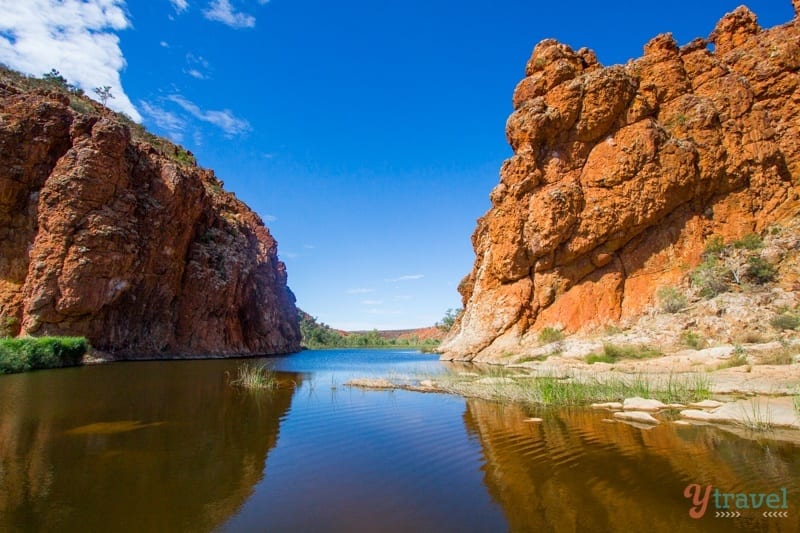
The permanent waterhole at Glen Helen Gorge is one of the national park’s top attractions and a favourite home to many species of desert wildlife.
It’s the perfect place to use as a base to explore the West MacDonnell Ranges.
Glen Helen Gorge lies at the headwaters of the Finke River, where you can walk along the riverbed between the gorge walls to see fabulous cycads.
The traditional owners also believe Glen Helen Gorge is the home of an ancient and powerful Rainbow Serpent, so consider it off-limits for swimming.
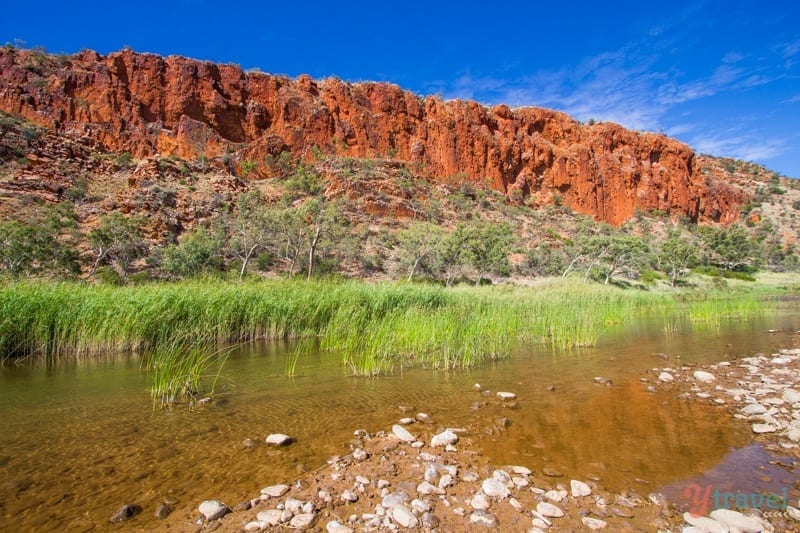
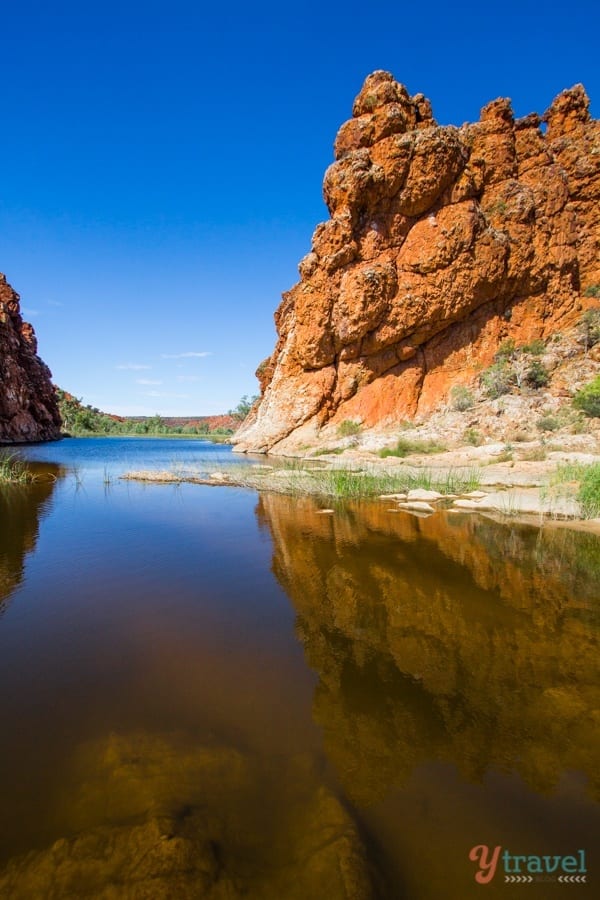
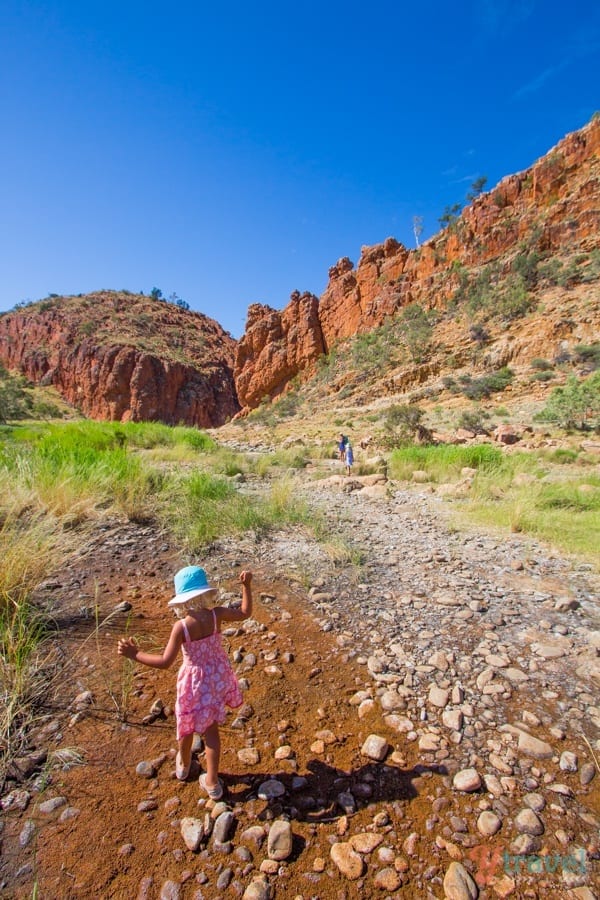
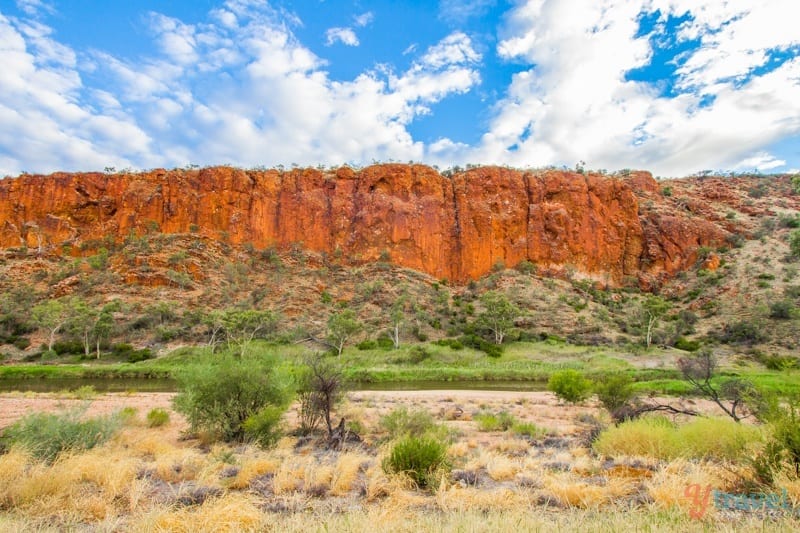
3. Camp at Glen Helen Homestead
We camped at Glen Helen Lodge for three nights in a powered site. We enjoyed chilling out in the homestead during the day after we’d finished our morning walks and swims in the West Macs.
There are several campsites throughout the park which have hot showers and toilets, but only basic facilities. You do have to pay overnight camping fees.
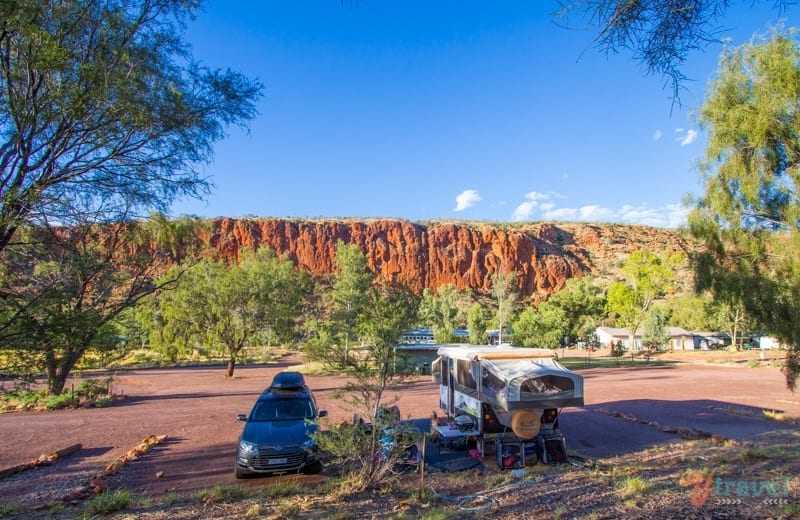
4. Have Breakfast at Glen Helen
We loved eating breakfast out on the decking at Glen Helen Homestead. The views out over the West Mac ranges were stunning and it is very serene watching the eagles soar quietly above looking for their own breaky.
Okay, so we loved having sunset drinks out here too!

5. Catch the Sunrise at Mount Sonder
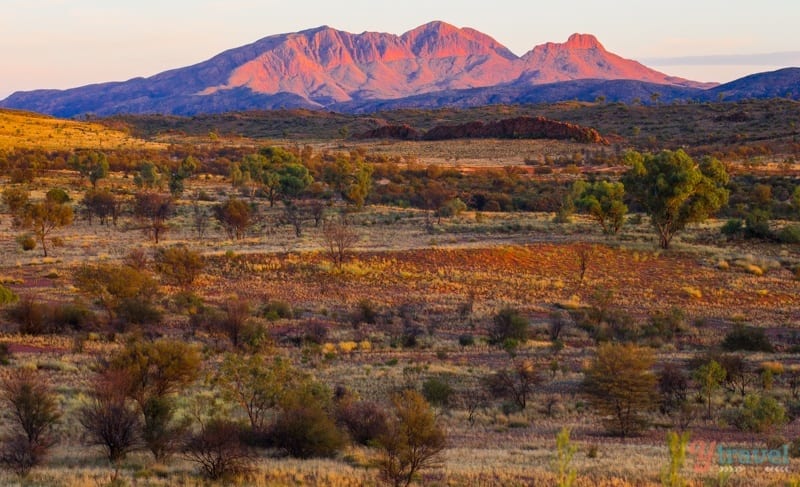
Five minutes down the road from Glen Helen Gorge is the Mount Sonder Lookout. This is the place to come for sunrise (and sunset).
You get stunning views over to Mt Sonder, the highest point on the Larapinta Trail and the West Macs ranges.
With its changing colours, it’s a favourite for painters, including the famous Australian artist Albert Namatjira.
The beauty doesn’t stop there though. Just look a little to the right for more beauty looking across the ancient bed of what is known as the world’s oldest river – the Finke – is an added bonus.

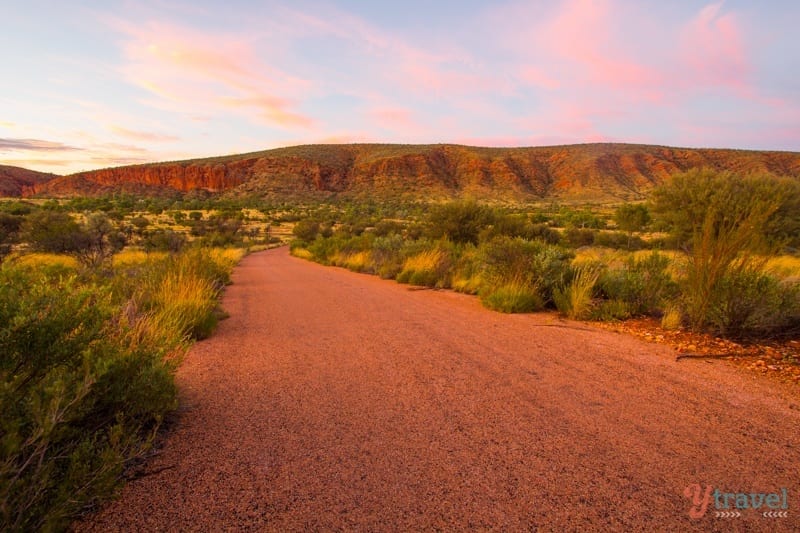
6. Go Tubing in Redbank Gorge
Redbank Gorge was one of the most delightful surprises and our favourite spot in the West Macs.
The gorge sits in the shadow of Mt Sonder and is known for its chilly water, but I found it so refreshing on our hot day.
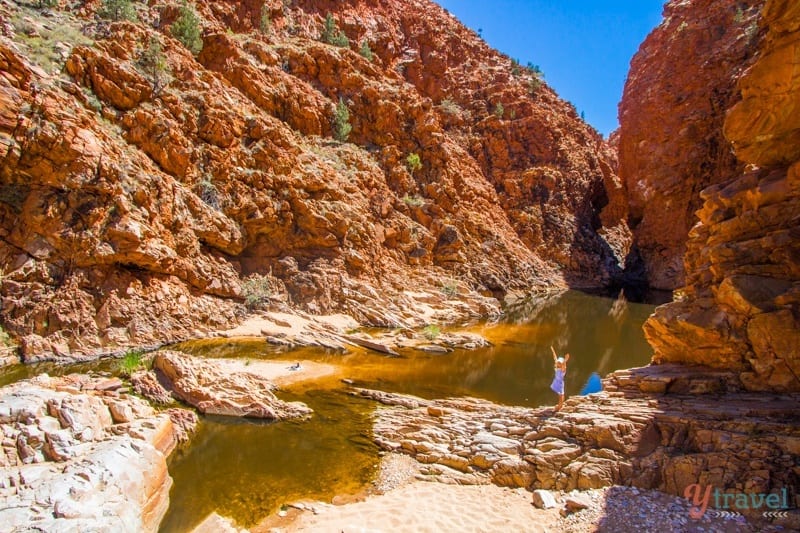
We grabbed a couple of tubes from Glen Helen Homestead and carried them along the 2 km return walk from the car park along the tree-lined, dry sandy creek bed into the gorge.
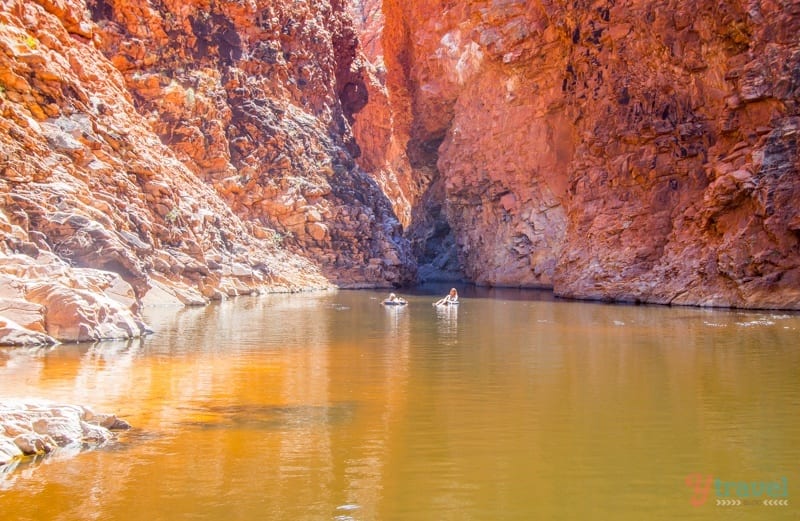
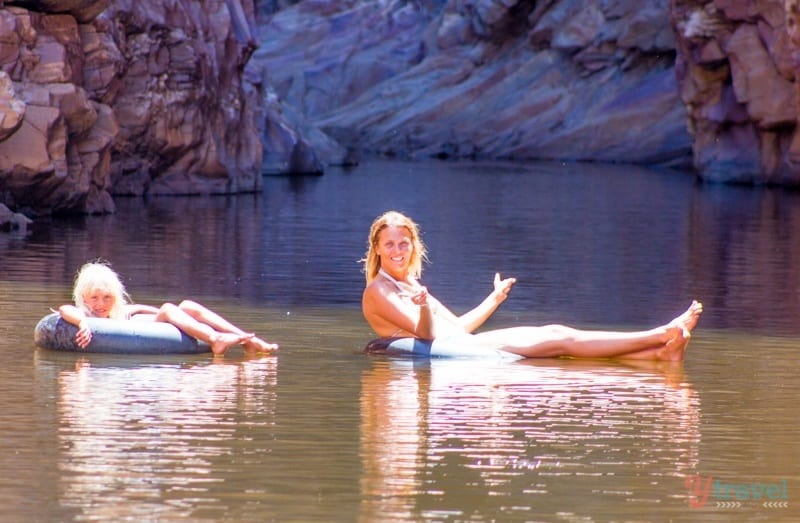
There’s a small swimming hole that leads to a narrow crack in the wall. Paddle on through it with your tubes and then clamber over the rocks that lead up to each new level.
There are six altogether and we only went up three. Just take care as snakes like to bask in the sunshine along the walls here. But, don’t fear they’re not interested in you!
It was such a fun adventure.
Kalyra and I set off first and giggled and splashed along with our legs with childish delight. I love these mini-adventures with Kalyra. She’s so curious and adventurous and keeps me young and brave.
She then kicked me out to have the same adventure with her Daddy while I swam in there with Savannah on my back. She insisted in joining the adventure, but only if I swam her in there!
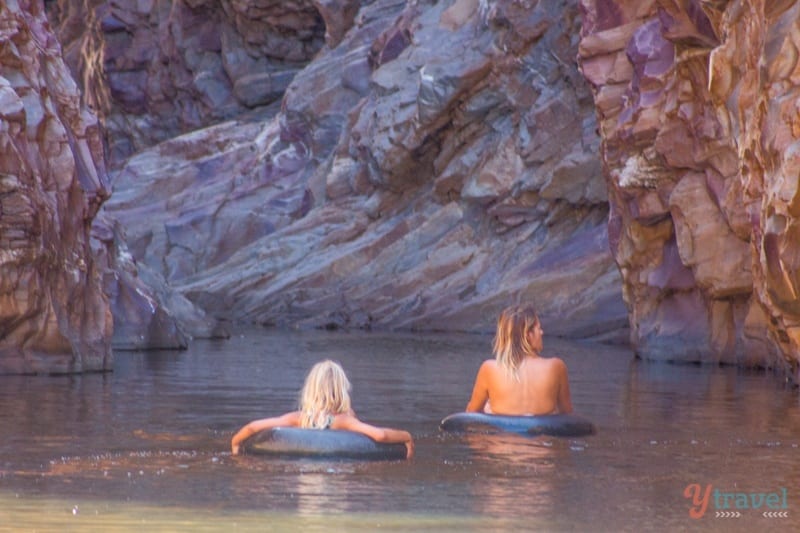
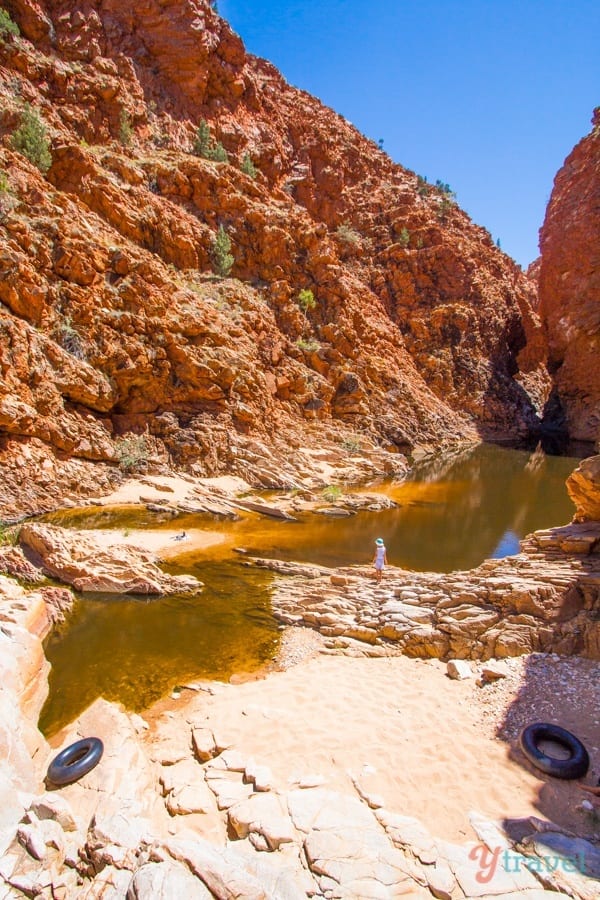
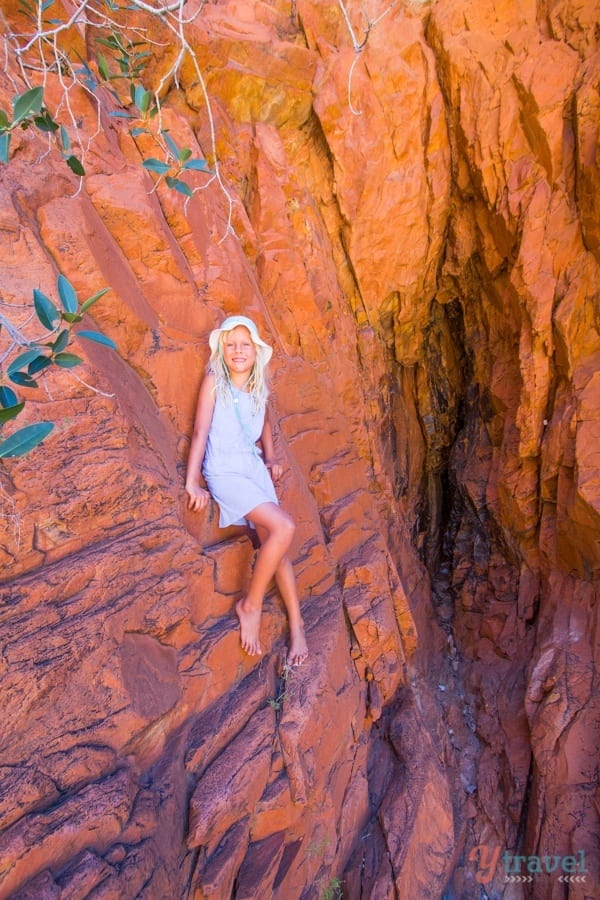
You can see a video of Gary & Amanda’s Redbank extreme adventures with a crocodile here:
Note: Just in case you don’t watch the video, there are no crocs in this part of the world. You’ll have to watch to see what sort of a croc joined them
7. Swim in Ormiston Gorge

Ormiston possibly has the biggest and prettiest nearly permanent swimming hole in the West Macs. It’s also the most popular.
Don’t worry there won’t be crowds disturbing your peace, that’s the beauty of the West MacDonnell Ranges.




You can take a short walk into the gorge for a refreshing swim. Or you can walk up to the steel viewing platform where you overlook the Ormiston Waterhole (20 min return). Off to the north you can see straight down into the majestic Ormiston Gorge with its rugged, quartzitic cliff faces and deep, sandy floor.

If you are feeling up to it, you can continue walking along the Ghost Gum Walk (a 1.5 hour loop) that winds down close to the gorge and eventually leads back to Ormiston Waterhole via the rocky floor of the Gorge.
There is also a kiosk open here and apparently serves a phenomenal ice coffee.
8. Visit the Ochre Pits

A short walk from the car park will take you to the Ochre pits, an area of brightly coloured small cliffs that local Arrarnta Aboriginal people have used for thousands of years for their ceremonial paint and is even a place for trade.
The layers of white, yellow and red ochre of the cliffs are so rich and earthy. Don’t touch the ochre, it’s a sacred site and so protected.
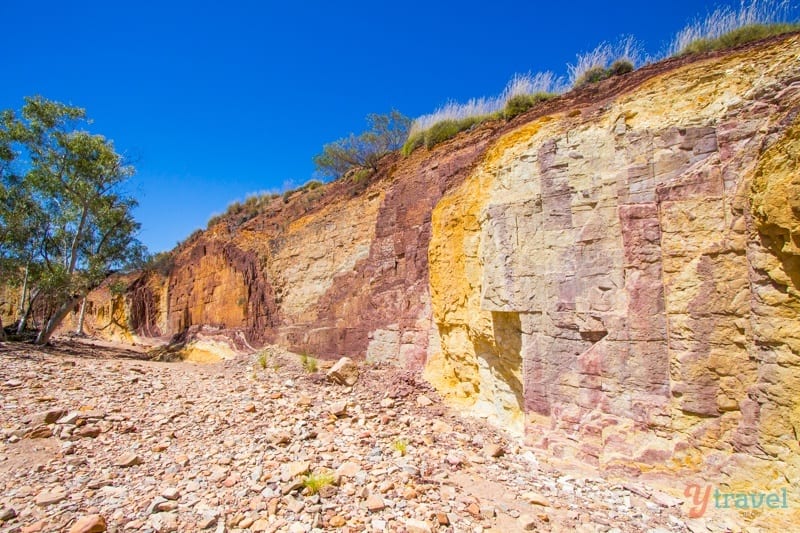

9. Hike through Serpentine Gorge
Serpentine Gorge offers a lovely day hike through River Red Gums, reeds, and alongside idyllic semi-permanent water holes.
There is no swimming here it has a protected and fragile ecosystem.
There’s a walk up an exposed, rocky slope with very little shade to a lookout, but the views from the summit.
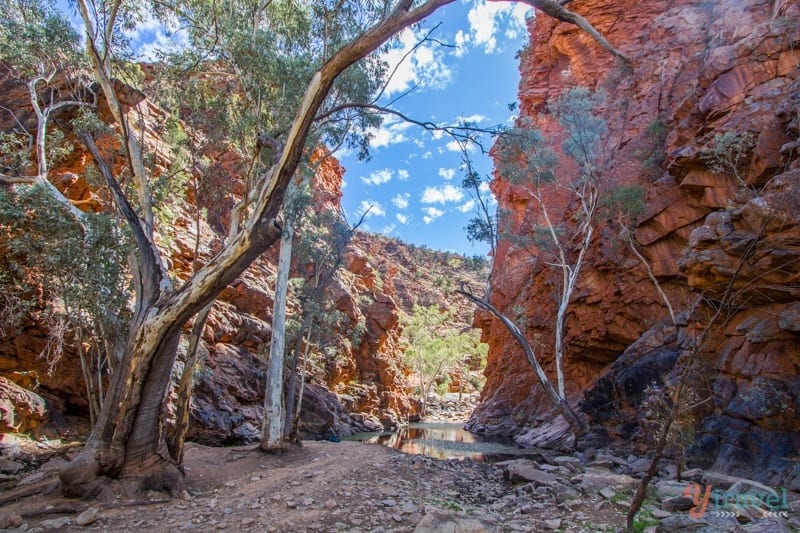
We didn’t attempt it, but heard the 360 degrees views along the narrow, winding Serpentine Gorge were beautiful and gives a unique perspective of the MacDonnell Ranges.
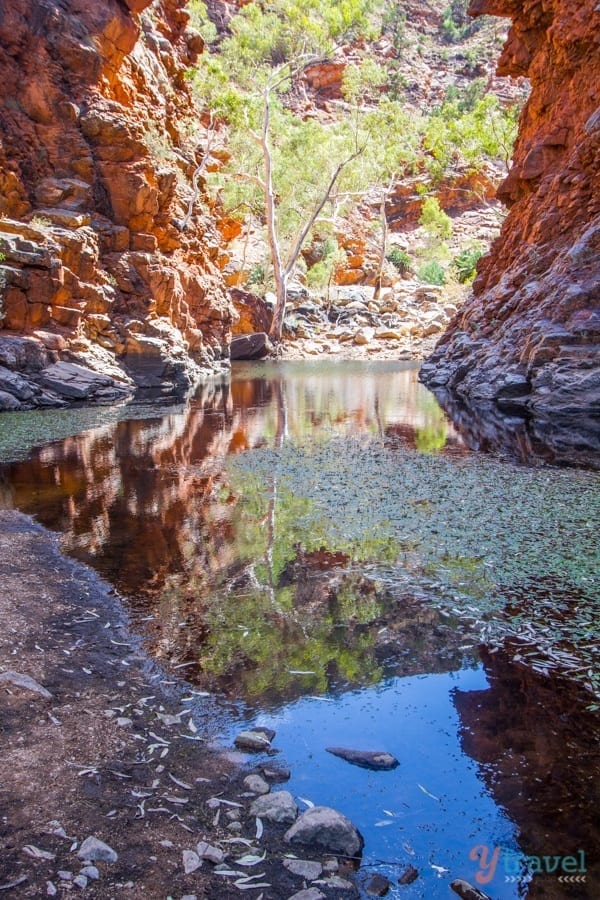


10. Swim in Ellery Creek Big Hole waterhole
A favourite swimming hole for the locals, Ellery Creek sits right near the car park, making it a great spot for those who aren’t keen on walking in. It’s also a great spot for a picnic.


11. Check Out Standley Chasm
This is the place you want to visit around noon when Mother Sun decides to ignite the splendour of the gorges fiery walls rising 80 meters above.
When the sun’s light shifts across the cleft, the walls of the chasm glows golden, orange and red. It’s a very old women’s business healing place.

When the sun’s light shifts across the cleft, the walls of the chasm glows golden, orange and red. It’s a very old women’s business healing place.
There’s a pretty 15- 20 min walk along the creek besides rare ancient cycads, and where spring-fed pools give the valley floor a lush, tropical oasis feel. When you visit the Red Centre Way, your idea of what a desert is will be tipped upside down.
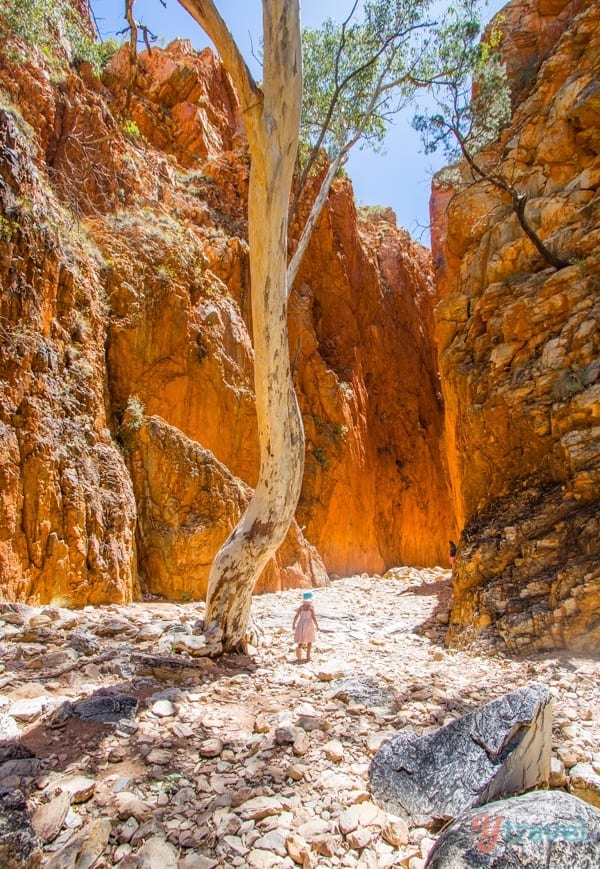


There is another short walk that heads up westwards from the back of the Kiosk. The walk climbs up a valley and finishes on a saddle with spectacular views of valleys, creeklines and mountains off to the west.
There’s a kiosk at the start of the walk, where you can get a nice lunch with serenity views and a yummy cup of coffee. Standley Chasm is Aboriginal owned and operated. Entry fee is $10 for adults, $6.50 for kids,
$25 Family of 2 Adults/2 Kids. You can also camp for $15
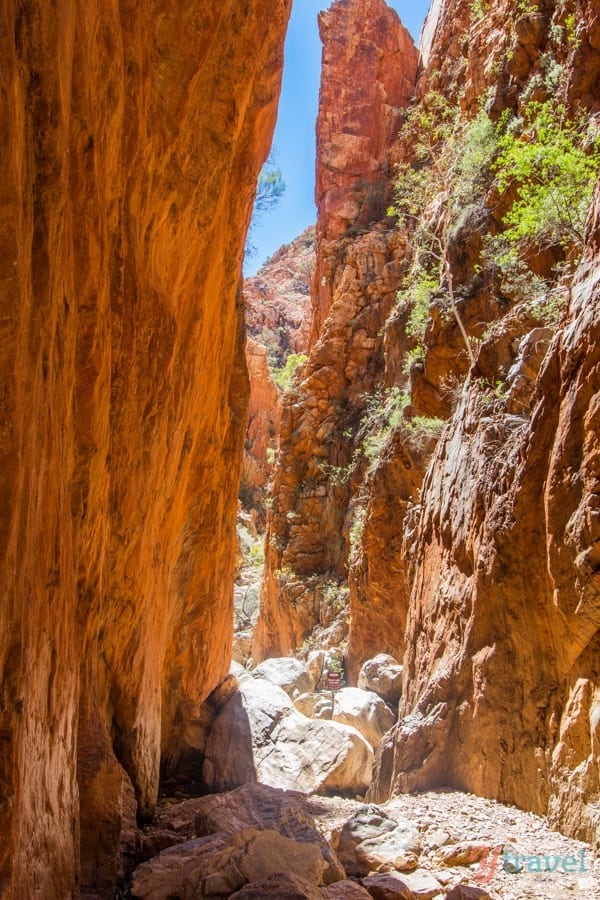

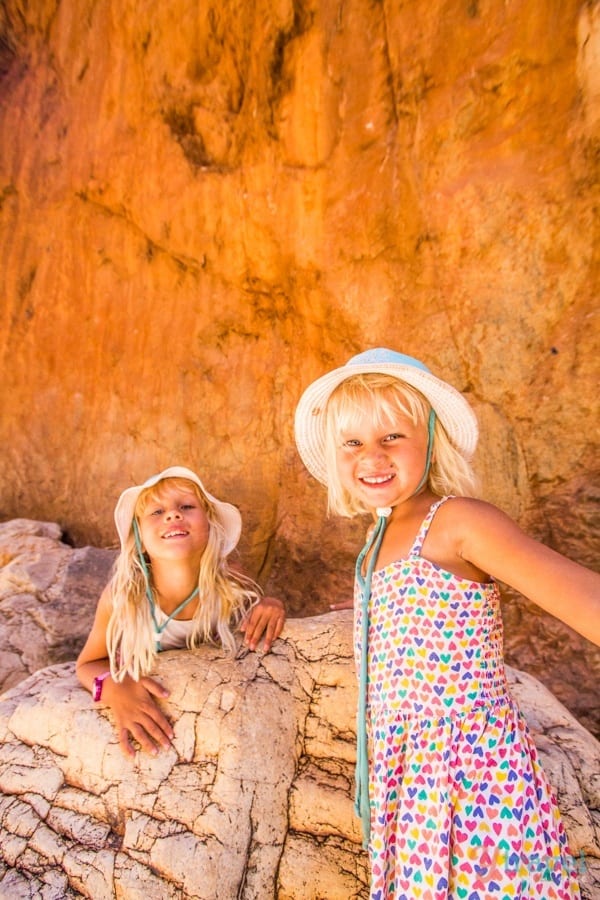
12. Check out Simpsons Gap
This prominent waterhole is just a 25-minute drive from Alice and is popular to cycle to along the sealed 17km bike track (one way) starting from Flynn’s grave.
The area is an important spiritual site to the Arrarnta Aboriginal people, where several dreaming trails and stories cross.
At dawn or dusk Simpsons gap is renowned as a place to see Black-Footed Rock Wallabies along the gap’s short walking track.
The best chance to see a rock-wallaby is early mornings or late afternoon as they don’t like the midday heat.
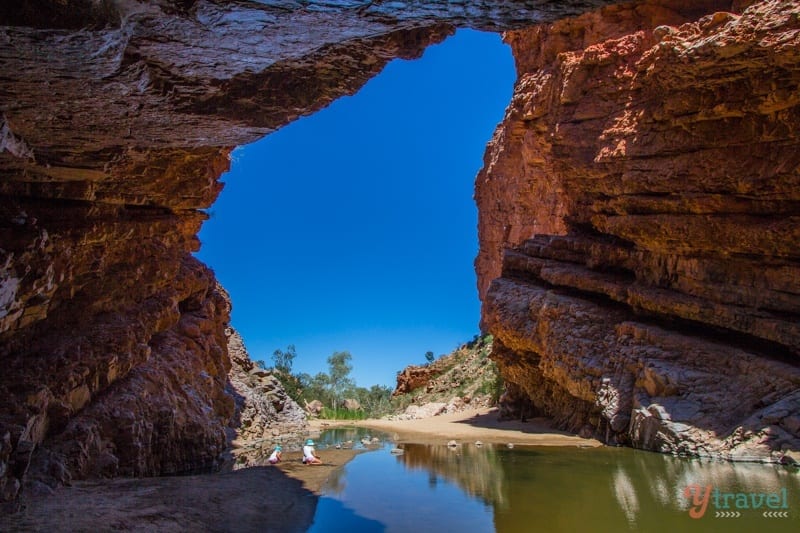
13. See the Birds of Prey at Desert Park
This is an easy trip from Alice Springs. I took the girls there for a morning adventure. We had a great time learning about dingos, watching the bird show and meeting an eagle in person.
The Desert Park in Alice Springs takes you through the different desert landscapes to see the flora and fauna of each one. We had a great time learning about dingos, watching the bird show and meeting an eagle in person.
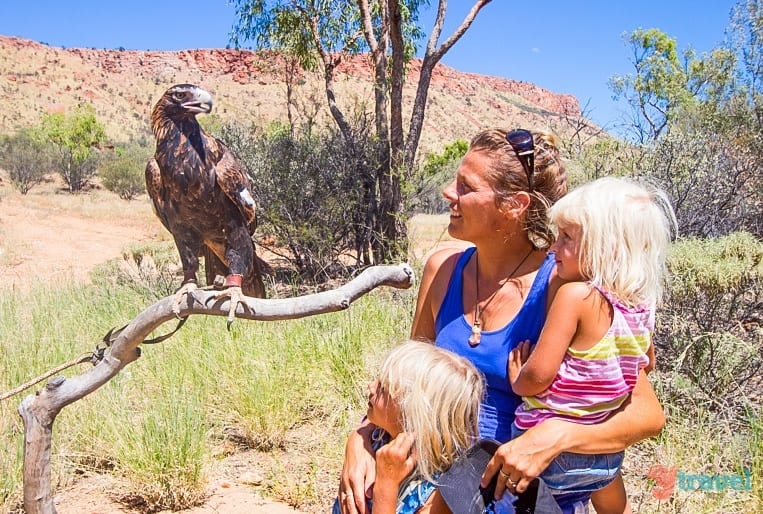


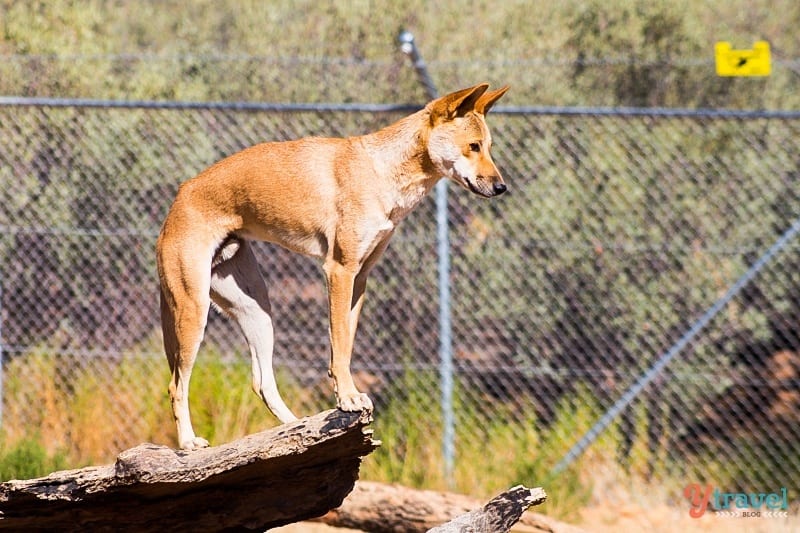
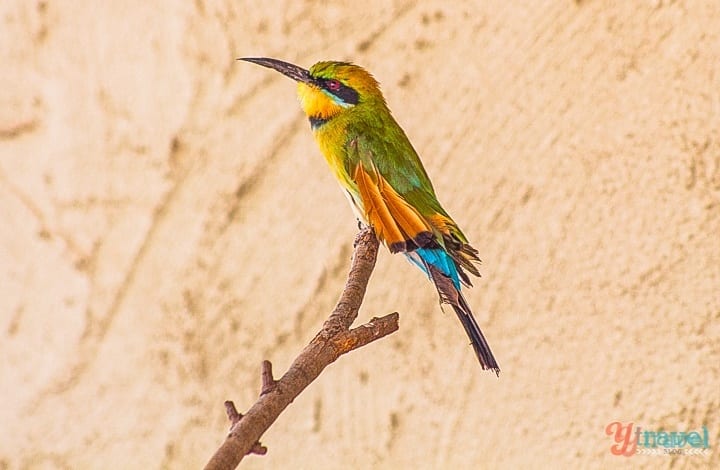
Other Places To Visit Near West MacDonnell Ranges
Of course, there’s so many things to do in the West MacDonnell Ranges, but we can’t let you pass by these other amazing places nearby that you should add to your itinerary.
14. Drive to Gosse Bluff (Tnorola) and Tylers Pass
We passed both of these on the way to Glen Helen Gorge and the West Macs from Kings Canyon along the Red Centre Way.
Around 142.5 million years ago an object from space, believed to be a comet about 600 metres across, crashed to earth, blasting a crater some 20km across.
Today’s land surface is about 2km lower than the original impact surface and the bluff is about 5km in diameter, reduced over time by erosion.

According to Aboriginal belief, Tnorala was formed in the creation time, when a group of women danced across the sky as the Milky Way.
During this dance, a mother put her baby aside, resting in it’s wooden baby-carrier. The carrier toppled over the edge of the dancing area and crashed to earth where it was transformed into the circular rock walls of Tnorala.
We drove into have a look at Gosse Bluff. It’s a sacred Aboriginal site so you are asked to not walk in certain places. We just walked up to a lookout point from the car park. It’s eerily silent, but so pretty.
Tylers Pass is the place to catch a great panoramic view of Tnorala (Gosse Bluff) and the surrounding areas.
It helped give us a great visual reference point when we later visited the Cosmos Centre and learned about meteorites. Best not to think about them crashing into earth!
15. 4WD in Palm Valley
One place we’d heard so much about and were disappointed to miss as Palm Valley.
You need a hardcore 4WD to access it (or commercial tour). Palm Valley is located in the Finke National Park and is home to the world’s oldest river, the Finke River and the Red Cabbage Palm, that is only found in Palm Valley.
Tips for Visiting West MacDonnell Ranges
Before you go, I have a few tips to share with you to make the most of your trip.
- Pack plenty of water. The outback is hot and sunny, and can lead to dehydration easily.
- Put on sunscreen to protect your skin.
- Know when to go. The warmer months are between December and February where temperatures can reach 34°C – 36°C.
- Make sure you charge your cameras! There’s a lot of amazing views to photograph.
- You don’t need a 4WD, there are two roads – Larapinta Drive and Namatjira Drive – which are both paved.
Final Thoughts on Visiting West MacDonnell Ranges
“Places we’d never heard of are some of our faves!”
We often set out on our travels focused on checking off everything on our bucket list. The bucket list is a must; you want to see those places and have those experiences you haven’t stopped thinking about.
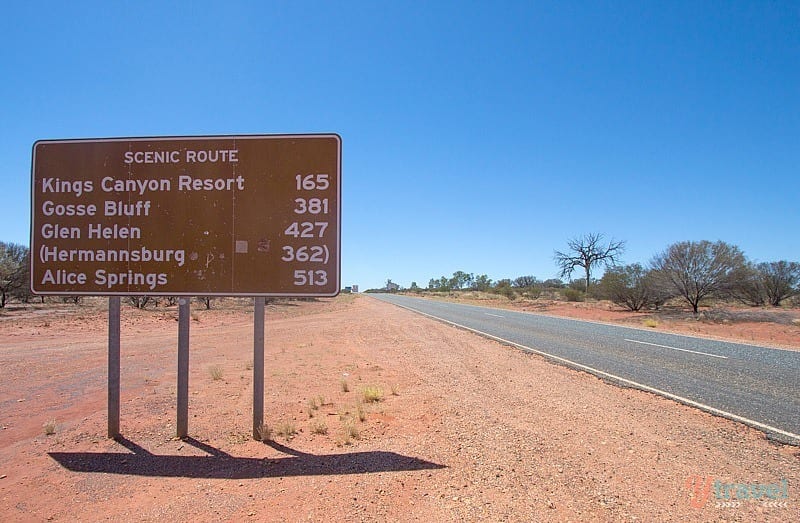
But, you need to leave space in your journey for the surprises.
The West MacDonnell Ranges were one of our biggest surprises. We’d never have visited there if it not for recommendations from other travellers and our readers.
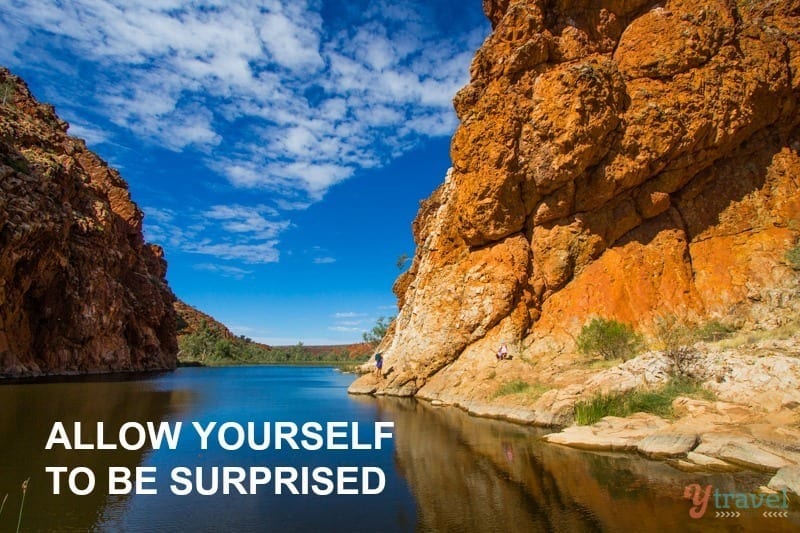
We knew our road trip along the Red Centre Way from Uluru to Alice Springs in the Northern Territory was going to be epic. I mean we finally go to visit Uluru – a bucket list dream.
Thanks to our relationship with Amanda and Gary from Travel Outback Australia and the folks at Tourism Northern Territory, we also discovered the Red Centre Way in Central Australia has an infinite number of surprises waiting for you to explore.
One of those incredible surprises – The West MacDonnell Ranges.
Tours in Alice Springs
More Northern Territory Travel Tips
- 34 Fun things to do in the NT, Australia
- Things to do in Kakadu National Park, NT
- 9 Ways to Experience the Magic of Uluru, Australia
- Katherine Gorge in photos – A Natural Treasure of the Northern Territory
- Lovely Darwin Accommodation in Cullen Bay
- Highlights of a Northern Territory Road Trip from Darwin
- Best Things to Do in Darwin (+places to eat & drink)
- My Dream Visit to Darwin and Arnhem Land: T-QUAL Tick Race
- 25 Outstanding National Parks in Australia
- 14 Best Road Trips in Australia
- 20 Places to Put on your Australian Bucket List
- 45 Things to know before visiting Australia
- Best Cold and Hot Winter Destinations in Australia
Pin to share:
